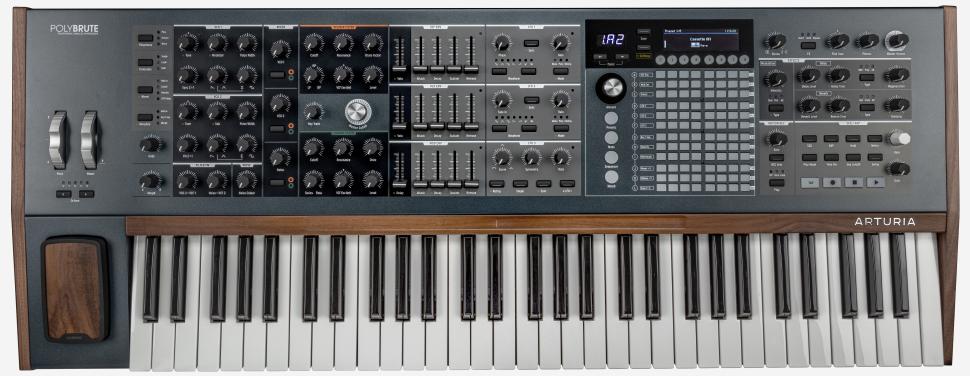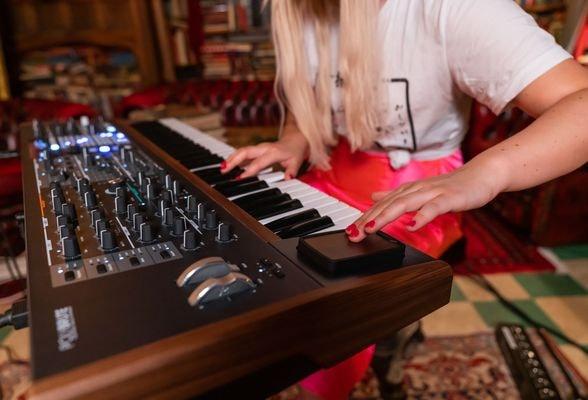Review: Arturia PolyBrute

Instrument Feeling
Externally, the PolyBrute closely resembles Arturia‘s previous synthesizer flagship the MatrixBrute, and we wanted to flip up the Minimoog-style control panel right after unpacking; however, that didn‘t work out. Unfortunately, this option was omitted from the PolyBrute.
The workmanship of the PolyBrute is impeccable - the sturdy case combines dark lacquered metal with walnut wood elements. The feel is excellent, and only the halved matrix with 8x12 small illumi- nated soft buttons is a bit at odds with the classic look and feel. With dimensions of 97 x 38 x 11 centimeters and a weight of a good 20 kg, the PolyBrute makes a clear statement against the current smaller-lighter-portable trend.
Performance Aids and Good Keyboard
The Morphee controller, a mixture of X/Y pad and expression pedal, also makes for an unusual design. The ribbon controller above the keyboard is placed so inconspicuously in the wooden frame that it can be overlooked. Unfortunately, it does not cover the entire keyboard range, but it can be used to modulate filter frequency and other sound parameters as well as to implement interesting pitch changes in the style of a theremin. The keyboard has a full 5 octaves, handles velocity, as well as aftertouch, and is one of the best keyboards we‘ve ever had the pleasure of playing on an analog synthesizer.
Direct Operation
With the exception of the matrix and the associated knob, there are no duplicate assignments here; each function has its own control element. For some special functions like changing the characteristic of the envelopes or synchronizing the LFOs, you have to dive into menus with the help of the large graphic-capable display and the 8 associated buttons, whereby well thought-out shortcuts marked on the surface facilitate the operation. Overall, we liked the operation of the PolyBrute very much, we hardly had to take a look at the manual during the test.
Limited Connectivity
Compared to the MatrixBrute, Arturia has cut down on the connections. The head- phone jack on the front is exemplary. On the back, you will find the stereo output in the form of two (unfortunately) unbalanced jack sockets. The three pedal inputs:
Expression 1+2 and Sustain allow expressive playing via foot. Memory Protect and the MIDI trio should be self-explanatory. Unfortunately, CV/Gate connections for connecting analog equipment were omitted, there is only Clock IN/OUT for synchronization. We also missed an input for processing external audio signals with filters and effects like in the MatrixBrute.

Fully Automated incl. Editor
The USB port not only acts as a USB MIDI interface, but also connects to Arturia‘s free Editor software. With this software you can edit the synthesizer and save sounds. When used as a VST plug-in, this allows for Total Recall, which is the saving of sounds along with the current song in the DAW. Especially nice: The USB port provides its own channel for connecting to the software, so the editor and DAW don‘t get in each other‘s way! Almost every control on the MatrixBrute receives and sends MIDI controllers and can be automated in the DAW.
2 Brute Oscillators
The oscillators have also been slimmed down a bit compared to the MatrixBrute, there are only two instead of three per voice. In comparison, however, MicroBrute and MiniBrute only have one of these special Brute oscillators. So, in terms of its sonic possibilities, it goes far beyond the usual standard fare. And the 6-voice PolyBrute has a total of 12 oscillators available, which can also be layered in unison mode to form a super-wide wall of sound.
Metalizer, Sync and FM
You can smoothly crossfade between the different basic waveforms, while PWM and supersaw provide fat detuned sounds. Oscillator 1 offers the Metalizer for metallic sounds rich in overtones, this wavefolding can also be applied to waveforms other than triangle for the first time and is, thus, even more sonically productive. Oscillator 2 does without it, but can be soft or hard synced to oscillator 1 and can also frequency modulate it. The sub-oscillator oscillates an octave lower and only offers a sine wave; a square wave option would have been nice here.
Slightly Less Brutal
Sonically, the oscillators are somewhat tamer and less aggressive than the other Brute synthesizers, even with the gain turned up; Arturia has probably added more headroom here. This makes sense for a polyphonic synthesizer and so the PolyBrute is also interesting for those who couldn‘t get much out of the characteristic Brute sound.
What’s extraordinary is the flexible design of the pitches of the two VCOs, which can be set in semitones or also in selectable scales.
Two Different Filters
The special Brute sound of the Arturia synthesizers is created by the oscillator and the extraordinary Steiner multimode filter with adjustable feedback loop, which was also built into the PolyBrute. It offers 12 dB slope; the 24dB option of the MatrixBrute was omitted as was the upstream drive saturation.
Filter 2, on the other hand, is a classic ladder filter and is limited to a 24dB low-pass filter in the PolyBrute; an adjustable distortion provides harmonically distorted sounds here instead of BruteFactor. It should be emphasized that, even at high resonance values, there is hardly any loss in the bass range, as is often the case with ladder filters. Both filters go into self-oscillation at high resonance values, but only the ladder filter can be played tonally clean.
Stereo Option
Between the filters, Arturia has placed a large silver master cutoff control. It controls the cutoff frequency of both filters simultaneously, relative to the res- pective set value - perfect for live performance or parameter modulations. The keytracking of the filters is also controlled globally for both filters together.
There is one interesting novelty that’s been added: Both filters can be distributed separately in the stereo panorama, which allows for spectacularly wide pads and leads. Since each oscillator, as well as the noise generator, can be routed to Steiner or Ladder filters or both filters at will, and these in turn can be connected in parallel or series, the sound options are impressive. From the classic Moog lead to crisp HP/LP combo sequences in MS20 style to ultra-wide synth pads; everything can be implemented here.
Three Envelopes
The PolyBrute offers three envelopes, each with the standard attack, decay, sustain and release parameters. They are controlled by faders, which could have been a bit longer, but in return you have access to all three envelopes at the same time and don‘t have to switch. In addition to the flexible standard setting, the envelopes also offer a percussive mode for fast and crisp progressions. Both intensity and times of the envelope can be controlled via velocity, which makes PolyBrute a more than passable bass synthesizer that didn‘t have to hide behind a Moog Sub37 in a direct comparison, either. The third envelope is not internally pre-wired with filter or volume, but can be freely assigned. It also has a delay fader, with which you can delay the use of the modulation.
Flexible Modulators
As additional modulation sources, the MatrixBrute has 3 LFOs with lots of options, whereby LFO3 can also be used as a mini-envelope with variable progression. In addition, you can add your individual fourth LFO live with Motion-Record, and for classic vibrato there is another LFO available.
Matrix Sequencer
The matrix has been more than halved compared to the MatrixBrute and offers 8 x 12 multi-colored soft buttons. They are a bit small and wobbly and have no tactile pressure point, but you will get used to this after a while. In preset mode, you can use them to directly select 96 stored sounds in each of the 8 internal banks. The matrix is also used for editing the sequencer. A sequence can be up to 64 steps long, divided into four rows of 3 with 8 steps, one below the other. The four rows are composed of note, accent and slide. Note input is step-by-step or real-time, up to 6-voice polyphonic. Parameter movements, such as filter moves, can also be recorded in three modulation tracks. The recorded sequence can be triggered and transposed via keyboard in the lower section. On the upper keys, you can play another sound over it. In addition to the classic arpeggiator, there is also the matrix arpeggiator, where you can influence the sequence and octave position of the played notes via the buttons.
Modulation Matrix
The matrix is also used to switch modulation sources and destinations. To do this, press one of the eight round buttons below the large, graphics-capable display and simultaneously move any knob ( for example, the cutoff of the Steiner filter) to select it as the modulation destination. On the Y-axis, you will find the envelopes, LFOs, velocity and the three Morphee axes, among others.
Now all you have to do is press the button corresponding to LFO1 on the Y-axis and Steiner cutoff on the X-axis, and then use the knob to set the amount of rhythmic filter modulation (negative or positive). The button lights up, with a further press it goes out again and the modulation is deactivated - it could hardly be simpler.
Morph Function
The absolute highlight and unique selling point among analog synthesizers is the Morph function. With the PolyBrute, you can create two completely different sounds and either layer or split them, that is, play different sounds with the left and right hand. But you can also morph continuously between these two sounds, and this morph control can also be automated.

Intuitive Operation
The operation is very easy. Turn the Morph knob to the left and set your desired sound or access a preset. Copy this sound to position B and change various parameters such as filter frequency, envelopes, reverb space and delay feedback. Or choose completely different sounds, such as a pad at position A and a crunchy bass at position B. And then use the knob or Morphee or another playing aid to morph smoothly between the two sounds, with each changed parameter sliding smoothly from one value to the other. If you like an intermediate value in the process, you can save that blended sound as a new preset. On the one hand, the morph function allows subtle, organic changes to sounds and sequences. On the other hand, sounds with different settings of the filter routing and effects can also be used to create spectacular soundscapes. And the operation is so intuitively designed that we could lose ourselves for hours in new sound worlds during the test.
Three Effects
Three separate effects are provided in the PolyBrute. They are generated digitally and are available globally. For the two possible sounds (A/B) you cannot set different effects; only different effect proportions. The modulation effect including chorus, phaser, flanger, bitcrusher and other variations is designed as an insert effect. Delay and reverb also offer different algorithms and can optionally be used as send effects and, thus, can be taken out of the analog signal path. The effect parameters, such as intensity and time, can be modulated (for example, via LFO or sequencer) and can also be integrated into the morphing.
Verdict
The wait for the first polyphonic analog synthesizer from Arturia was worth it, because the French have created a modern classic with the PolyBrute. PolyBrute is not based on any vintage synthesizers, but impresses with an unique concept, design and sound character. The sound is extremely versatile for an analog synthesizer. In addition to flexible oscillators, dual filters and a large modulation matrix, the morph function, which makes the PolyBrute completely unique, is primarily responsible for this. Proven performance aids like arpeggiator and ribbon controller form a perfect combination with modern features like the polyphonic matrix sequencer, recording of parameter runs, Morphee controller, storability and operation via VST plug-in. This very good 5 octave keyboard, with a great feel and well thought-out operation makes the PolyBrute a highly desirable instrument for classic synth sounds, but also particularly for creating your own signature sounds with high recognition value.
Want more? Get more!



Subscribe to the digital edition of BEAT Magazine via Plugins-Samples.com and get more gear, in-depth workshops, reviews and 11 GB exclusive plugins and new sounds with every monthly issue!
Subscribe to Beat Magazine for only 4.99€ per month
